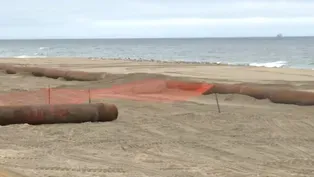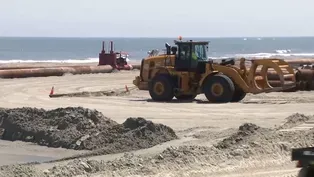NJ Spotlight News
Time to reevaluate the money spent replenishing beaches?
Clip: 6/11/2024 | 8m 20sVideo has Closed Captions
Interview: Andy Coburn, Western Carolina University
The Jersey Shore has become reliant on regular beach replenishment to protect oceanfront property and support the region's lucrative tourism industry. But the process of beach replenishment is expensive and becoming ever more expensive.
Problems with Closed Captions? Closed Captioning Feedback
Problems with Closed Captions? Closed Captioning Feedback
NJ Spotlight News is a local public television program presented by THIRTEEN PBS
NJ Spotlight News
Time to reevaluate the money spent replenishing beaches?
Clip: 6/11/2024 | 8m 20sVideo has Closed Captions
The Jersey Shore has become reliant on regular beach replenishment to protect oceanfront property and support the region's lucrative tourism industry. But the process of beach replenishment is expensive and becoming ever more expensive.
Problems with Closed Captions? Closed Captioning Feedback
How to Watch NJ Spotlight News
NJ Spotlight News is available to stream on pbs.org and the free PBS App, available on iPhone, Apple TV, Android TV, Android smartphones, Amazon Fire TV, Amazon Fire Tablet, Roku, Samsung Smart TV, and Vizio.
Providing Support for PBS.org
Learn Moreabout PBS online sponsorshipAndy Coburn is a Jersey native but now studies Beach replenishment trends for the program for the study of developed shorelines at Western Carolina University his research focuses on the scope and cost of beach replenishment around the nation and is Raising questions about if the work to replenish makes sense from a cost benefit perspective he joins me now Andy Coburn great to have you uh here and to talk about this which is obviously your expertise when we think about these Beach replenishment projects obviously the sand is meant to be washed away but the extent that the state and the federal government have put money behind it um has likely ballooned beyond what folks thought a decades ago when a lot of these projects began why is the work so very expensive now we're talking like three billion dollars since it's been tracked uh over the last century right well thank you Brianna it's it's a pleasure to be back and chatting with you about Beach nourishment once again um it's expensive because it it's expensive the the the um the the process of beach nourishment entails a lot of very costly technical analyses um using a dredge to pump sand from the ocean onto a beach is very expensive there are not a lot of companies that can do that kind of work at that scale so there's a supply and demand issue a lot of fuel as you can imagine that's required to run these barges and these pumps and the heavy equipment so it's just a very costly thing to do and and it costs we used to say about 10 or 15 years ago we used to have we had a general general rule of Thug that said it would cost about a million dollars a mile to Nisha Beach and that was anywhere little done uh now we'd Say it'll cost $5 million before a grain of sand is even pumped on the beach give us an idea quickly I'm just curious about the cost per cubic foot now compared to even let's just say 10 years ago what's the contrast the cost per cubic yard of sand is increasing and has been increasing over the past 20 to 30 years I think what we're going to end up seeing is when we go back and do Trend analysis of the data we're going to see a significant increased in the cost of beach nourishment nationally in about 2004 2005 when Florida was hit by so many hurricanes I believe they had to start they ran through the alphabet and had to start using the Greek letters which is kind of rare but not unheard of and the demand for Beach nourishment after that that season was so great that that we saw a significant increase in prices and prices don't ever come down as we all know prices go up and maybe they slow down in terms of how they increase but they do not ever go down and for Beach nourishment we have never seen prices go down or costs I should say when we chat with folks um from the Army Corps for example you you know obviously their priority is to protect infrastructure at large whereas when you talk to especially local you know municipality leaders um there's a lot of concern about protecting tourism dollars but it seems as though this is becoming untenable there's so much working against it are we at that point yet and do we have enough other options or blueprints for other options that we can even begin to think about pivoting Beach nourishment is not undertaken because of the beach beach nourishment is undertaken to protect what's behind each and and you alluded to that when you talked about short storm damage reduction and and and so forth the AR cor Engineers that's their main charge when they do short protection projects storm damage reduction projects the termin changes over the years and that's that's that's their goal is to keep that beach in place keep a wide beach with an artificial Dune there to protect what's behind that beach should a storm happen and and that's the intent of nourishment does it do that how well does it do that to what extent what are the benefits what are the costs who pays questions that we are continuously asking we have been asking for the last 50 years probably and have yet to get a great answer a justifiable answer to us at least that allows us to say hey you know what the the the costs the public expenditure on nurishment is worth it we don't see that the Army Corps does cause benefit analysis that's true uh we have some issues with the the methodology I'm really want to get into the details of that but what we think is instead of looking at the benefits and the Army Corp of Engineers quantifies benefits as the re uh they quantify benefits in terms of property value right we think Army cor here should should identify Ben of nourishment in terms of the tax revenue generated by that property value now that might be somewhat confusing but it's a really really important distinction to make when we're looking at cost and benefits because the benefit of nourishment is almost exclusively to that front row first row of structures and properties and so I think we need to re evaluate cost and benefits equitability fairness those kinds of things where before we spend public money on nourishing beaches I want to move on and ask you how New Jersey Compares nationally in terms of um Federal and local money spent because we are right now looking at uh a state record some $50 million uh that's being planned to be spent on nourishment projects and I wonder how we Stack Up nationally um well New Jersey's number one I I'm born and raised in New Jersey so I I'm proud to say that um put that in context that by number one means the most money spent in any Coastal state in the United States has been spent in New Jersey to put sand on the beach so you know you can look at that as a a great thing or you can look at that as maybe that's $3 billion dollar of inflated to 2022 costs that's $3 billion that is no longer aailable to be spent on something else we need more and more of this sand every year uh it never seems to be that we need less and so how long can we keep this up and and are we going to run out of options well that's it you know that's that's the I used to say The $64,000 Question which that doesn't seem like a lot these days I can't answer that I really don't know what it is going to take for the powers that be to say to themselves or say to the general public or say to whoever hey you know what we don't think it's worth spending money to protect that front row of houses work what else can we do there are alternatives that we know are feasible we know they could work it's very difficult politically economically socially to get people to change their minds nourish what's going on for a hundred years it's real difficult to say hey how about doing something different we're trying you know we work with decision makers all the time we're at a research center at University so we have no authority to make make decisions we don't make policies we don't enforce things the best thing we can do is talk to decision makers and get them to understand there are alternatives there are other ways that we can look at roading shorelines especially during a time of change in climate and rising sea levels and say we can do this it'll be different it'll look different you have to get used to it but it's in the best interest of the beach the community the state the economy the environment everybody Andy Coburn is the associate director of Western Carolina University's program for the study of developed shorelines thank you so much Andy thank you Brian it was a pleasure seeing you
How climate change complicates NJ beach replenishment
Video has Closed Captions
Clip: 5/29/2024 | 6m 50s | More rapid erosion is forcing officials to consider alternatives (6m 50s)
NJ's beaches wash away faster than feds can fix them
Video has Closed Captions
Clip: 5/28/2024 | 8m 58s | Shore beach towns look for immediate fixes while nature strips away the sand (8m 58s)
Providing Support for PBS.org
Learn Moreabout PBS online sponsorshipSupport for PBS provided by:
NJ Spotlight News is a local public television program presented by THIRTEEN PBS













